"Fredericton man builds $300 solar furnace, decreases heating bill"
Fredericton man builds $300 solar furnace, decreases heating billCBC News
http://www.cbc.ca/news/canada/new-brunswick/fredericton-man-builds-300-solar-furnace-decreases-heating-bill-1.2527065
"SNIP.........................................
A Fredericton-area man says his heating bills are decreasing thanks to a solar furnace that cost him $300 to build.
Randy Buchanan, of Lower St. Mary's, modified plans he found online to build the heating unit from soda cans, aluminum eavestrough downspouts and an old double-pane window.
Buchanan is an environmental consultant and depends on heat and clean air to raise rainbow trout for his aquatic toxicology studies.
He began looking for heating alternatives after his bills for heat and an air exchanger soared this winter.
.......................................SNIP"
bloomington-lib
(946 posts)The temps were hot, 175 in the winter, and 215 in the summer, but I could never get the airflow strong enough to make a difference. I tried larger intake and exhaust plus added various vent fans, but it wouldn't raise the temp of the room. I think it would make a good water heater or food dehydrator but that's about it unless you're heating a very small room (which on a sunny day, opening your curtains would be easier)
sendero
(28,552 posts)... in this article, the guy is using something like a 4" inlet/ outlet pipe. That provides a cross section of 12.5 square inches. The vents in a typical air contitioning or heating system. They are typically 6" an area of 28.26 square inches.
I googled around and found several designs using various sizes of inlet/outlets pipe, including one with a 1.5" pipe, for a cross section of just 1.76 sq in. I'm pretty sure that is not going to work.
I think you would need a big pipe to get enough air through one of these things to do any good. What size pipe did you use?? From the high temp readings it sure sounds like you need bigger pipes!
I plan on building one of these some day!
bloomington-lib
(946 posts)I had it powered by a small solar panel so it was always on when the sun was shining.
It was fun to build and might try again later. I gave them to a friend that's planning on running a water line though the cans for an outdoor shower.
FLson
(93 posts)system. It's very elaborate and I used a lot of surplus electronics and stuff. Set up a few different solar panels and couple small wind turbines to power it. Uses a heating coil system and a piped plumbing system (metal exterior, plastic interior) that cycles the heated water throughout the attic allowing passive heat buildup. The raccoons love it and it doesn't supply all the heat but it does reduce the power bill immensely in the winter, and it's also rigged up to a solar heating system for my pool.
The one time I tested it without using my A/C, it kept the house as warm as 64 degrees while it was 32 degrees outside. If I improved it to run pipes down the wall spaces with additional small heating units, I could probably get it far warmer. I use a sophisticated insulation, temperature control, and monitoring system.
Kaleva
(38,713 posts)With that amount of air, the 6" round duct is desirable because anything smaller would lead to increased noise.
Here is a link to a btu calculator:
http://www.calculator.net/btu-calculator.html
One will see that even a small, normally insulated 10' X 10' X 8' room in a northern climate will need a fair amount of btu in order to maintain the room at a comfortable temp when it's cold outside.
You could also try and calculate how many btu's your solar heater is producing by first determining the the temperature rise (compare the temp of the input to the output), then measuring the cfm (or it may state the cfm on the fan itself) and using this formula:
CFM= ____BTU/Hr/(1.08 x Temperature Difference)
noamnety
(20,234 posts)to make a sleeping platform that would be heated if you are sleeping outside.
bloomington-lib
(946 posts)There's about twice as much volume as mine. Mine was only a little deeper than the cans, but with all of this extra space, there might be enough hot air to heat up a room.
http://solartoday.org/2011/03/harnessing-the-sun-lakota-style/

applegrove
(123,868 posts)panels. Wish I could invest in solar some day. But I don't have a house or property. Or the know how.
gejohnston
(17,502 posts)Woodwizard
(1,067 posts)I have been heating my shop with solar hot water using pool panels and polycarbonate twinwall glazing the pumps on the system are brushless dc pumps running off 12 volt photovoltaic panels it works great. I put radiant heat tubing in the floor before pouring the concrete. The trees shading it have been removed we have planted other trees in areas where solar is not an issue
I plan on building another for the shop and one for the house for our hot water and supplement heat.
A great resource for do it yourself is http://www.builditsolar.com
[img] [/img]
[/img]
[img] [/img]
[/img]
[img] [/img]
[/img]
[img] [/img]
[/img]
[img] [/img]
[/img]
mackdaddy
(1,625 posts)I took a few classes on solar water heating, but still learning. A big issue was freezing at night in the north, that seemed to be handled by either a drain back system that drained the collectors if it was too cold, or using a two stage system where a non-toxic anti-freeze liquid was used in the lines like ethel-glycol. The other problem they addressed was if it the collectors produced too much heat they had to be shut down or the heat dumped some way.
I put up a 10kw grid tie generating system, and since I bought a pallet lot of PV panels, I put another 1.1kw I intend to use as an off grid backup for well pump and refrigeration during power outages. I ran out of cash for the large battery bank and inverter, but decided to go ahead and mount the panels on the roof of the house, and wired them to the lower heating element of my electric hot water heater. (after disconnection the ac of course)
The heating element is a resistive load which works for ac or dc, so the energy from my PV panels is just dumped into the hot water heater and acts as a pre-heater for the water. The top element in a water heater usually does most of the work so I never have a problem of no hot water. I put some arc protection of the lower thermostat and have it set pretty high, but it hardly ever cuts off.
I wired a separate kwh meter to the input of the ac and it seems to use about 25% of the electricity it would use without the solar power dump. I have only had the water get too high once when I had about a week of sunny days last summer, which almost never happens in Ohio. PV panels are not the most efficient use for heating, but they are nearly zero maintenance, and the price has really come down, so I think we may see more PV used for heating in the future.
Woodwizard
(1,067 posts)No I do not have an issue with freezing it has antifreeze, this system is heating the floor of my shop pex tubing is in 6' of concrete with foam under the slab, I have a total of 6 zones approximately 450 feet on pex per zone as of now I am just running my center two zones with the one panel, I will expand when I add the next panel.
In the summer the heat will go to my lumber drying kiln I mill a lot of wood for making furniture since the panels are vertical overheating should not be an issue in the summer due to the higher sun angle.
mackdaddy
(1,625 posts)There are dozens of videos on Youtube of people who have build similar Solar Air heating boxes, but most just point a thermomerter at the output, and go see it get hot.
The real question is how many BTU's of heat are actually delivered into the room, with is temperature rise, but also amount of hot air delivered.
The best group I have seen who have done some real testing with at least some validity is the "Simply solar" and "Build it Solar" guys. They have built many variations, and there is a blog of many other self built versions of these.
Although most people started out with the cans in a row type, what they have found is that versions built with either aluminum downspout tubing, and another version with several layers of window screen have had superior performance. And they have done extensive side by side testing to show what works best.
Any of these can be constructed very inexpensively. I have not built any yet, but I would like to heat a workshop pole building, and may even try a portable one for the house.
Here are the links"
Overview Video of solar air heaters:
Main website of examples:
http://builditsolar.com/
http://www.simplysolar.supporttopics.com/
Blog and discussion group:
http://www.builditsolarblog.com/
Kaleva
(38,713 posts)Last edited Sat May 2, 2015, 07:57 PM - Edit history (1)
do not mention the actual btuh output. The few that do give enough info to figure it out leads me to believe that solar air heaters are not worthwhile for me to build and install, at least where I live (Upper Michigan), in the hope that I MIGHT get enough heat from such a device to maintain a comfortable temperature in a small room from around noon to mid afternoon on a clear, sunny, midwinter day.
However, that being said, I think they could be useful in the fall and spring when the temperature differential is much less so far fewer btuhs are needed to maintain a comfortable temp inside the home. With more daylight hours in the fall and spring and as most designs are inexpensive to build, I might make one and install it in my small house in town.
Edit: Here is a link to a site that has a btu calculator where one can change the outdoor temperature.